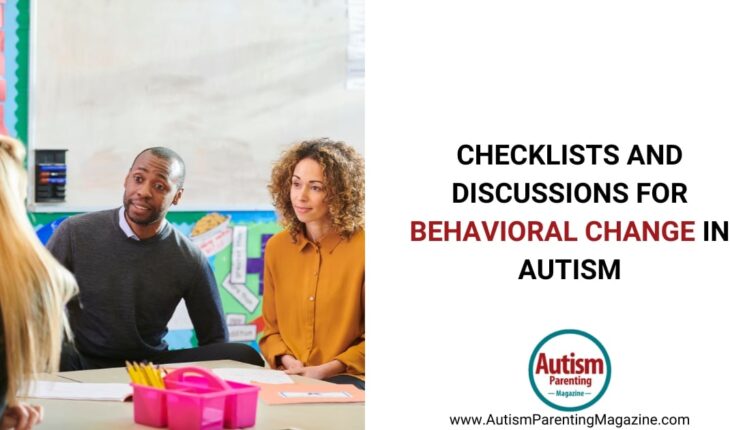Creating long-lasting behavioral change in special needs individuals starts with a strengths-based approach, and the key is team collaboration.
After all, these are the activities and situations where the individual is already happy, calm, and successful. Starting with a discussion of a person’s strengths and interests allows the team to bond, building trust before addressing potentially difficult or delicate topics.

Download your FREE guide on
Autism Behavior Interventions
The power of team collaboration in special needs behavioral change
Following that discussion with the individual’s disinterests and difficulties forms a complete picture of the individual as a “whole person,” rather than focusing only on their behavior. This approach provides a foundation for behavioral change by emphasizing strengths-based interventions that can be more effective in special needs care.
We offer two simple team discussion questions, each with its corresponding supportive checklist. These two questions are meant to supplement, not replace, the individual’s functional behavioral assessment or any other behavioral support structures already in place.
Team discussion question #1: Strengths and interests
Describe the situations and activities in which the individual will most likely be happy, calm, and successful.
When work, play, and learning are based on strengths and interests, individuals with special needs are often happier, healthier, and more successful. Their strengths and interests may be specific or narrow, and they may not always be able to communicate their likes, wants, and needs directly.
Team discussion example
A few years ago, we participated in a team discussion for a student we’ll call Brad. Brad struggled with social issues, was new to the school, and his staff hadn’t gotten to know him yet.
During most of the discussion, Brad sat with his head on the table, clearly not wanting to be there, and silently letting his team answer for him.

When asked about his interests, the team agreed that Brad liked music. What kind of music? The team wasn’t sure, suggesting children’s songs or oldies.
Brad finally raised his head (for the first time since he arrived) and said, loudly and clearly, “British rock bands of the 1960s and early 1970s.” Brad went on to name “The Beatles,” “The Rolling Stones,” “The Who,” “The Yardbirds,” and his personal favorite, “Donovan.”
This revelation changed everything for Brad. Music became his calming activity, his conversational icebreaker, and an essential part of his routine. A simple understanding of his interests helped his team better support him.
Checklist for strengths and interests
Use the following checklist to identify an individual’s strengths and interests. This helps teams create positive, strength-based interventions in special needs behavioral support.
___1. Favorite computer sites, programs, Apps, games, social media, websites, etc.
___2. Favorite music, types of music, musical artists, songs, radio stations, instruments, etc.
___3. Favorite visual media (TV shows, movies, videos, etc.)
___4. Favorite reading material (specific books, magazines, newspapers, websites, etc.)
___5. Favorite educational subjects, classes, or skill areas (math, science, history, etc.)
___6. Favorite toys and games (specific board, card, or electronic games, etc.)
___7. Favorite art and craft activities (drawing, painting, coloring, tracing, craft projects.)
___8. Favorite fitness activities (walking, swimming, shooting baskets, etc.)
___9. Favorite community sites (stores, restaurants, parks, libraries, etc.)
___10. Favorite foods and beverages (fruits, vegetables, meats, snacks, drinks, etc.)
___11. Favorite vocational jobs (active, mobile, physical, hands-on, organizational, service-related, office-related, etc.)
___12. Special abilities, skills, talents, hobbies, or intense interests.
___13. Special qualities (kindness, humor, honesty, determination, friendliness, sociability, helpfulness, etc.)
___14. Other:
Team discussion question #2: Disinterests and difficulties
Just as individuals have strengths, they also have unique disinterests and difficulties. Effectively addressing these challenges can lead to positive behavioral change.
These are often activities or situations where the individual experiences anxiety, difficulty, or distress.
That can be especially true for individuals with special needs, who might not always be able to tell us what’s wrong or what they feel or need.
Click here to find out more
`
Once we have developed a detailed list of an individual’s disinterests and difficulties, we can then ask:
- “What about these activities or situations makes them so stressful or unsuccessful?”
- “How do they differ from situations where the individual is already calm and successful?”
- “How can we begin to make the stressful situations look more like the successful ones?”
How we address such predictably problematic activities and situations is a team decision.
We may decide to temporarily eliminate a particular activity if it serves no immediate or important purpose. We might also adapt it toward clarity, simplicity, and success.
We use the following checklist to collect the team’s insights about an individual’s disinterests and difficulties.
Checklist for disinterests and difficulties
Describe those activities or situations in which the individual is most likely to experience anxiety, difficulty, or stress.
We use the following checklist to collect the team’s insights about an individual’s disinterests and difficulties:
___1. Particular activities, classes, or job:
___2. Particular times of day, week, month, or year:
___3. Particular places or environments:
___4. During transitions from one activity or location to another:
___5. When needing to wait for activities to become available (or to end):
___6. If a request is delayed or denied:
___7. If feeling rushed:
___8. If encountering unexpected changes in expectations or routines:
___9. In response to directions or corrections (being asked to do something,
stop doing something, or do something differently):
___10. In response to sensory stimuli (sight, sound, touch, taste, or movement):
___11. Within food-related activities or situations:
___12. Within social or interpersonal situations:
___13. When experiencing illness, discomfort, or fatigue:
___14. Other:
A team-based approach to behavioral change
Finally, when responding to both sets of questions, we encourage the team to be as specific as possible and assign someone in the group to capture the team’s observations, insights, and experiences.

Don’t try to evaluate or judge the team’s responses in real-time. Just try to get it all down. You can sift through the input later. Some responses are diamonds. Some are diamonds in the rough. You just never know where the secret may be hiding.
FAQs
Q: How do you write strengths in an IEP?
A: Strengths in an IEP are written by focusing on the student’s abilities, interests, and positive attributes that support their learning. This includes identifying activities or subjects where the student excels and how these strengths can be leveraged to support their overall development.
Q: What factors must the IEP team take into consideration?
A: The IEP team must consider the student’s strengths, challenges, academic performance, social and emotional needs, and any relevant assessments or evaluations. They also take into account the family’s input, the student’s goals, and any necessary accommodations or services to support the student’s success.
Q: What are strength-based IEP goals?
A: Strength-based IEP goals focus on using a student’s strengths to overcome challenges and achieve specific, measurable objectives. These goals build on what the student does well and apply those abilities to help improve weaker areas.
Q: What are examples of strengths and weaknesses for students?
A: Examples of strengths may include creativity, problem-solving skills, strong memory, or teamwork. Weaknesses could include difficulties with organization, managing time, handling frustration, or specific academic areas like math or reading.
References and further reading:
Wehmeyer, M. L. (2019). Strengths-based approaches to educating all learners with disabilities: Beyond special education. Teachers College Press.
Pounds, L., & Cuevas, J. (2019). Student Involvement in IEPs. Georgia Educational Researcher, 16(1), 23-47. https://eric.ed.gov/?id=EJ1206045
Sanderson, K. A., & Goldman, S. E. (2022). Understanding the characteristics and predictors of student involvement in IEP meetings. The Journal of Special Education, 56(1), 3-13. https://journals.sagepub.com/doi/abs/10.1177/00224669211008259






